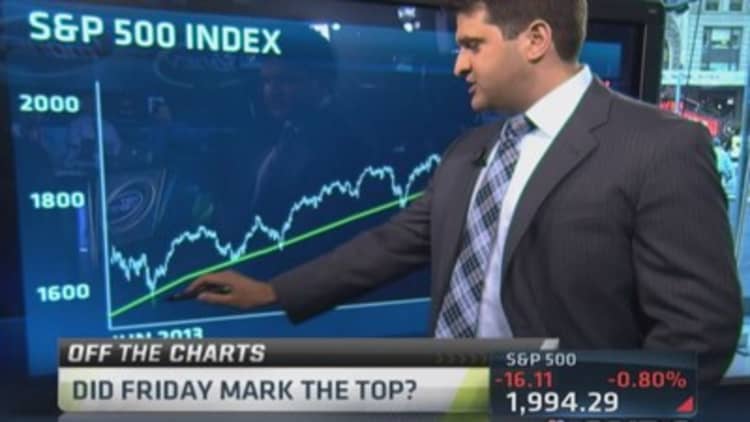
The divergence in play for much of this year is a theme likely to dominate in the days and months ahead.
The market is grappling with the Federal Reserve and prospects of higher interest rates along with weak growth globally, or, as Cameron Hinds, regional chief investment officer at Wells Fargo Private Bank, put it, "Two negative arguments off of two different themes."
Last week, the Federal Open Market Committee repeated a pledge to hold interest rates near zero for a "considerable time" once the Fed is done with its asset-purchase program next month. The central bank also hiked its median estimate for the federal funds rate at the end of next year to 1.375 percent versus 1.125 percent in June.
"Bonds are saying they don't believe Fed will raise as quickly as what they (FOMC members) are saying," Hinds said.
Read MoreThe market's next Fed fear: The exit strategy
"The bond and equity markets are in somewhat of a tug of war, with both signaling different market views as to when rate rises could occur," said Peter Cardillo, chief market economist at Rockwell Global Capital.
The divergence trend is conspicuous in both markets and economies, with strength in the U.S. and U.K. standing in contrast to softer growth in Europe, and central bank policies on markedly differing courses as a result.
"The U.S. Federal Reserve's latest estimate of interest rates suggested a sooner-than-anticipated move away from ultralow rates. At the same time, a 'no' vote in last week's Scottish referendum cleared the way for a rate hike by the Bank of England," Russ Koesterich, global chief investment strategist at BlackRock, said in a research note.
The European Central Bank is contending with very different problems of how to expand its balance sheet and provide more monetary accommodation, while prospects for a Fed rate hike in 2015 are already having an impact in the U.S. bond market, with the short end of the Treasury curve rising along with the dollar, a scenario that has helped push commodity prices lower.
Read MoreEU's Barroso: Europe will avoid recession
Further evidence can be found In the U.S. stock market, where recent gains have not been universal.

"Small caps largely sat out last week's rally and defensive sectors, particularly utilities, are off roughly 4 percent from their summer peak," Koesterich noted ahead of Monday's session, which had small caps leading Wall Street's decline.
For stocks, a marginal tightening in monetary conditions suggests being cautious on those segments of the equity market with hidden rate exposure. This includes both small caps and certain defensive-income plays, like utilities—both of which have historically proved more vulnerable to contracting valuations as real rates rise," Koesterich noted.
"Longer term, we do not believe modestly higher interest rates are bad for stocks," said Hinds.


